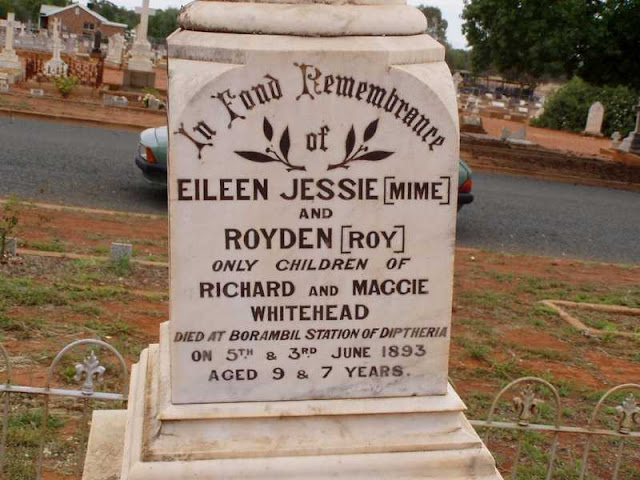People, individual people, get lost in stories of epidemics. Temptation exists for overstatement, for generalising, for blame, for retribution. And advantage of vulnerable victims and their families is taken.
Maggie Whitehead died three days after contracting bubonic plague during a brief stopover in Sydney, on her way to England from her home in Condobolin in western NSW. Her husband, Richard, was the owner of the massive 'Borambil Station'. Maggie began life as a Cameron, of the Western District Camerons of Victoria. Dead within three days, with Richard not being able to even see her. So, I wondered what became of Richard.
So, I searched the listing for Condobolin in the Australian Cemeteries Index. I did not find Richard, but I did find Maggie. And ... I also found their only two children, Eileen and Royden. They both died in 1893. Of diptheria. Mime was aged 9 and Roy was aged 7. Blimey!
But, still no Richard.
I did find a Richard Whitehead who died in Parramatta in 1941, but he was a member of a family of carpenters. Not my Richard, I guessed. I still have not found him. There are four Richard Whiteheads listed in Victoria that were in possible years, but they all died in the city. Not my Richard, I guessed.
However, preparing this post helped me to bring to mind, the dreadful year of 1892 endured by my own 2*G-GM, Annie Howell, who lost three children to diptheria at the Wilcannia Hospital: Aileen, aged 13; Lindon, aged 8; and, Elsie, aged unknown.
Why the wrought iron fencing to top and tail this post. It is around the grave of Maggie in North Head Cemetery #3. Somehow, I simply needed to embrace this family, and a metaphor was my only weapon.
| This is my contribution to the Taphophile Tragics community. |





12 comments:
Incredible research Julie.
A wonderful post. Thanks for bringing me to a reality beyond my experience.
Fantastic post! I didn't even know Bubonic Plague was stillaround in those days. How sad to notonly lose his children to disease, but his wife also. those times getting sick must have been terrifying.
Poor Richard, maybe he simply gave up and disappeared.
Beneath Thy Feet
That's so sad!
Stark tragedy in one family! Bubonic Plague must have been a ravaging terminator that we today, with all our immunisations, barely can understand! Strange that Richard's last resting place is so elusive, but maybe not so strange! I imagine that he would have been a very lost man!
It was a tough life back then. Horrible family story.
I like seeing these close up shots of corroded metal.
Wonderful post, it is so lovely that you put so much thought and effort into them all.
Unbelievable hard times our ancestors would have had to endure, not many people would cope these days.
My goodness. Your post makes me appreciate life today. How hard it must have been a century or more ago. "Bubonic Plague" - give me shivers.
I fear poor Richard did not have much happiness after 1900.
Teasing down the stories of the people you find in the cemeteries is very engrossing for you and us.
how sad. is that why it is on her stone, that she died in quarantine and he never got to see her?
(and is there a typo on that first stone? contacted in sydney?)
Post a Comment